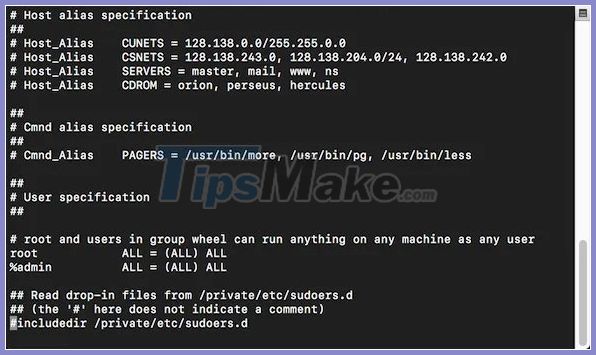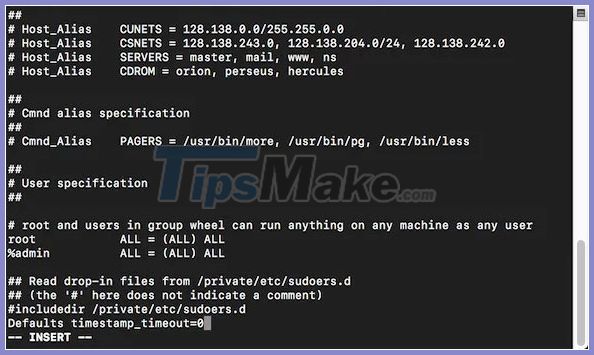The reason and how to edit sudoers file in Linux
What is file sudoers?
The sudoers file is a text file located in '/ etc / sudoers' and controls how sudo works on the machine. You're probably familiar with sudo's primary role of elevating the current account's privileges to root, superuser privileges on all Unix-based systems. This allows users to execute commands that are currently prohibited.
When to edit sudoers file?
When you install Linux (or macOS) for the first time, the first and default users are automatically added to the sudoers file so that the file can run administrative tasks using the sudo command. However, if you create a new user account, it will not have superuser rights by default. If you need to grant it superuser permissions, you'll need to edit the sudoers file and add this user account to it.
How do I edit sudoers file?
Never edit a sudoers file in a regular text editor. This can lead to concurrent editing and corrupted files, potentially denying any admin access. Sudoers have to be edited by running visudo in Terminal, like so:
sudo visudo
Note that you need to use sudo to run visudo. This will open the sudoers file using the default text editor in Terminal (Nano by default).

What does changing file sudoers do?
The main job of the sudoers file is to determine which users can use sudo for what. It also has some simple options that you can adjust first to get a feel for how visudo works.
Change timeout sudo
By default, entering the sudo password will elevate your permissions until you close the shell or exit. This can be insecure, and some people prefer entering a password every time they use sudo.
Step 1. Run sudo visudo as mentioned above.
Step 2. Press Alt + / to navigate to the end of the document. If you are using Vi or Vim, press Shift + G .

Step 3. Create a new line at the end of document and add the following line:
Defaults timestamp_timeout=0

This will set the sudo timeout to 0 seconds, so you will have sudo privileges for 0 seconds after you execute the first command. If you prefer a different time period, enter that value in seconds.
You can also set the timeout to ' -1 ', which gives you an infinite grace period. But don't do that! That might accidentally crash the system one day.
Step 4. Press Ctrl + O to save and Ctrl + X to exit.
Restrict who can use sudo and what
The main purpose of the sudoers file is to control which users can run sudo. Without sudo, users cannot elevate their permissions. If you have multiple users accessing the same system through the shell, you can control their access by setting the values in sudo.
Every sudoers file will have the following line:
root ALL=(ALL) ALL
This allows the root user on all hosts to use all users to execute all commands. ALL is a special value in the sudoers file, meaning 'no limit'. The syntax is as follows:
username hostlist = (userlist) commandlist
If you want to add another user as root, just copy the root line and change the user like this:
alexander ALL=(ALL) ALL
For more control you can add a line like this, which will only allow 'alexander' users to run apt-get update .
alexander ALL=(ALL) /usr/bin/apt-get update
Put '%' in front of the user and it will define a group. The line below will allow all users in the "admin" group to have root privileges. This will be the group defined by the operating system permissions groups.
%admin ALL=(ALL) ALL
Change the visudo editor
Depending on the version of Linux you are running, there are two main ways to change the editor.
For Ubuntu, you will want to run the Terminal command below:
sudo update-alternatives –config editor
You should see something like this:
There are 4 choices for the alternative editor (providing /usr/bin/editor). Selection Path Priority Status ------------------------------------------------------------ * 0 /bin/nano 40 auto mode 1 /bin/ed -100 manual mode 2 /bin/nano 40 manual mode 3 /usr/bin/vim.basic 30 manual mode 4 /usr/bin/vim.tiny 10 manual mode Press enter to keep the current choice[*], or type selection number: 3
If you want to choose Vim as a visudo editor from the Nano default option, you'll need to tap on option 3 and press Enter.
For other Linux versions you will want to add a new line to your '~. / Bashrc' file like below:
export EDITOR="vim"
Then save the file. The visudo editor will change to Vim.
You should read it
- Micro editor in Unix / Linux
- What file is XSD? How to open, edit and convert XSD files
- PDFio.co - Service of creating, protecting, converting PDF, ... online, support Vietnamese, free on many devices
- What file is PAT? How to open, edit and convert PAT files
- What file is 3GP? How to open, edit and convert 3GP files
- M3U is what file? How to open, edit and convert M3U files
- What is a config file? How to safely edit the config file?
- Simple and fast steps to edit Host File on Windows 10
May be interested
- PDFio.co - Service of creating, protecting, converting PDF, ... online, support Vietnamese, free on many devices
 pdfio.co is a free and account-free web service that allows you to edit pdf files easily at any device without software.
pdfio.co is a free and account-free web service that allows you to edit pdf files easily at any device without software. - What file is M4A? How to open, edit and convert M4A files
 the file is part of an extension .m4a is an mpeg-4 audio file. they are usually found in apple's itunes store and are considered as the default format of songs when downloaded.
the file is part of an extension .m4a is an mpeg-4 audio file. they are usually found in apple's itunes store and are considered as the default format of songs when downloaded. - What is a config file? How to safely edit the config file?
 software configuration text files are called config files (configuration files). if you want to improve your computer's knowledge, you will need to know what the config file is and how to edit it.
software configuration text files are called config files (configuration files). if you want to improve your computer's knowledge, you will need to know what the config file is and how to edit it. - How to use Zsync to transfer a file part in Linux
 zsync is based on rsync, another popular linux tool to synchronize files or directories, and it's very easy to use. most linux distributions already have zsync available in the package repository, so it's easy to install and get started.
zsync is based on rsync, another popular linux tool to synchronize files or directories, and it's very easy to use. most linux distributions already have zsync available in the package repository, so it's easy to install and get started. - Learn the file system and folders on Linux operating systems
 linux and unix file systems are organized in a hierarchy similar to the structure of a hierarchical tree. the highest level of the file system is the root directory, denoted by a slash '/' (root directory).
linux and unix file systems are organized in a hierarchy similar to the structure of a hierarchical tree. the highest level of the file system is the root directory, denoted by a slash '/' (root directory). - How to install and use GNU nano to edit files on Linux
 one of the most popular command-line text editors on linux is gnu nano, which comes pre-installed on most modern linux distributions.
one of the most popular command-line text editors on linux is gnu nano, which comes pre-installed on most modern linux distributions. - Basic file system in Unix / Linux
 a file system is a logical collection of files on a partition or a disk. a partition is an information store and can be combined into a hard disk if desired.
a file system is a logical collection of files on a partition or a disk. a partition is an information store and can be combined into a hard disk if desired. - Simple and fast steps to edit Host File on Windows 10
 file host helps manage access to websites on computers and laptops. however, file host can make you inaccessible, or you want to block a certain website.
file host helps manage access to websites on computers and laptops. however, file host can make you inaccessible, or you want to block a certain website. - What file is XSD? How to open, edit and convert XSD files
 a file with the .xsd extension is most likely an xml schema file. this is a text-based file format, which defines the validation rules for xml files and explains xml forms.
a file with the .xsd extension is most likely an xml schema file. this is a text-based file format, which defines the validation rules for xml files and explains xml forms. - Basic Linux commands everyone needs to know
 when using linux, you should also learn basic linux commands to make operations quicker and easier. here are some basic commands on linux you should know.
when using linux, you should also learn basic linux commands to make operations quicker and easier. here are some basic commands on linux you should know.










 How to use sudo without password in Linux
How to use sudo without password in Linux How to fix 'No Installation Candidate' error in Ubuntu
How to fix 'No Installation Candidate' error in Ubuntu How to enable Dark Mode in Ubuntu 20.04 LTS
How to enable Dark Mode in Ubuntu 20.04 LTS How to install Hyper Terminal in Ubuntu 20.04
How to install Hyper Terminal in Ubuntu 20.04 How to use the history command in Linux
How to use the history command in Linux How to set up Bluetooth in Linux
How to set up Bluetooth in Linux